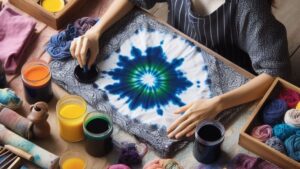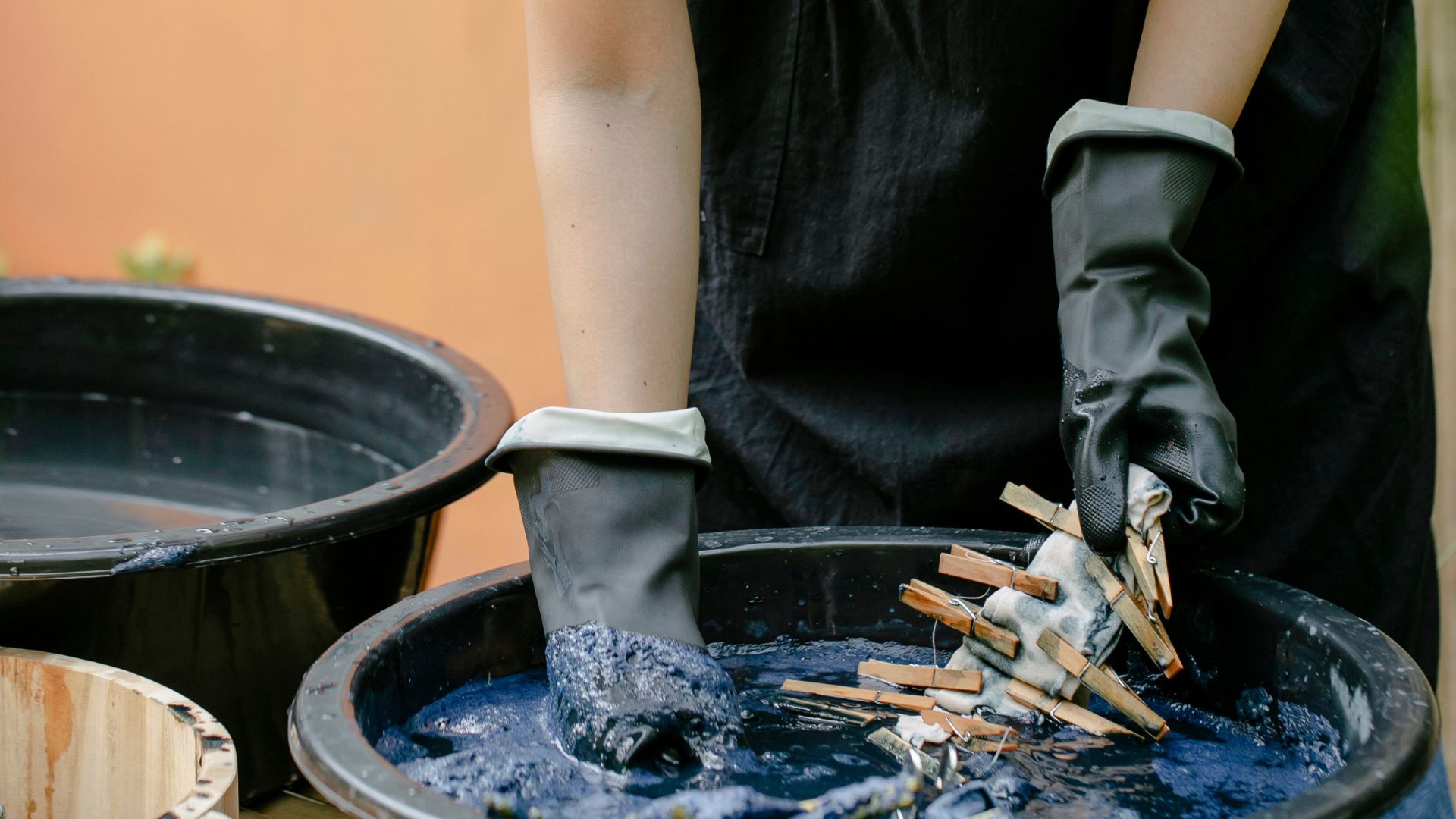Tie-dyeing is a vibrant, expressive craft that infuses color into our lives. Yet, the final step often sparks a common debate among enthusiasts: should you set tie-dye in a plastic bag or wrap? Let’s dive into this colorful conundrum to uncover the best practices.
Setting the Scene: Understanding Tie-Dye Setting
Before delving into the bag vs. wrap debate, it’s crucial to understand the tie-dye setting process. Setting involves allowing the dye to penetrate and bond with the fabric fibers, ensuring colors remain vivid wash after wash.
The Plastic Bag Perspective
Some crafters advocate for using a plastic bag to set tie-dye. Here’s the rationale: enclosing the dyed fabric in a plastic bag creates a warm, moist environment. This controlled environment is believed to enhance color absorption and fixation, intensifying the vibrancy of your creation.
The Wrap Wisdom
On the other hand, wrapping tie-dye in plastic wrap or cling film has its proponents. This method offers a tight seal, preventing dye from bleeding onto adjacent areas of the fabric. The snug wrap also helps maintain moisture and heat, fostering optimal conditions for the dye to set.
The Verdict: Bag or Wrap?
In truth, both methods have merits. However, the choice may depend on various factors:
- Convenience: A plastic bag might be more readily available for larger projects, while plastic wrap offers precision for smaller items.
- Dye Type and Fabric: Certain dyes or fabrics may react better to either method. For instance, thicker fabrics might benefit from a bag’s roomier space, allowing better color absorption.
- Personal Preference: Some crafters swear by one method over the other based on their past experiences or preferences.

Tips for Optimal Tie-Dye Setting
Regardless of your chosen method, here are some tips for a successful tie-dye setting:
- Patience Pays Off: Allow ample time for the dye to set. This usually ranges from a few hours to overnight, depending on the dye and fabric type.
- Heat and Moisture: Ensure the dyed fabric stays warm and moist during the setting process. This aids in color fixation.
- Rinse and Reveal: Once set, rinse the fabric thoroughly until the water runs clear. Follow up with a wash cycle to remove excess dye.
External Resources for Further Guidance:
For a deeper dive into tie-dye setting methods and techniques, explore these reputable resources:
- Tie-Dye Instructions from Tulip Color: Tulip Color provides comprehensive tie-dye instructions and tips for various methods.
- Dharma Trading Co. Tie-Dye FAQ: Dharma Trading Co. offers a vast FAQ section covering tie-dyeing techniques, troubleshooting, and more.
- DIY Network’s Tie-Dye Tips: DIY Network shares step-by-step tie-dye guides and creative ideas.
So,…
Ultimately, the choice between a plastic bag or wrap for tie-dye setting boils down to personal preference, convenience, and the specifics of your project. Experimentation often leads to discovering what works best for you. So, grab your dye, embrace the colorful chaos, and let your creativity flow.
The Science Behind Tie-Dye Setting
Understanding the science behind tie-dye setting can shed light on why these methods work.
Color Chemistry at Play
When you apply dye to fabric, it contains pigments that need to bond with the fibers to create lasting colors. Many dyes, especially those used in tie-dyeing, are reactive and require certain conditions to effectively bond with the fabric.
Plastic Bag: A Colorful Cocoon
The plastic bag method creates a micro-environment where heat and moisture are trapped. This setup mimics ideal conditions for reactive dyes to bond with the fabric. The warmth facilitates the chemical reaction between the dye and fabric, promoting better color absorption.
Plastic Wrap: Precision and Protection
Wrapping tie-dye in plastic wrap provides a tight seal, preventing colors from bleeding into unwanted areas. This precision is particularly useful for intricate designs where you want to maintain distinct patterns. The wrap also traps heat and moisture, aiding in the setting process.
Alternative Methods Worth Exploring
While the bag and wrap methods are popular, other techniques exist:
- Air Drying: Allowing the fabric to air dry without containment, though it might result in less intense colors.
- Steam Setting: Applying heat through steam to enhance color fixation, often used in professional settings.
Environmental Considerations
In today’s eco-conscious world, it’s vital to consider the environmental impact of our crafting methods. Both plastic bags and wraps generate waste. As an alternative, consider reusable options like cloth wraps or containers to set tie-dye, reducing single-use plastics’ footprint.
Final Thoughts
Setting tie-dye in a plastic bag or wrap is a small yet pivotal step in the colorful journey of creating vibrant designs. Whether you choose the cocoon-like embrace of a plastic bag or the precision of plastic wrap, the goal remains the same: to lock in those mesmerizing colors and bring your artistic vision to life.
Remember, experimentation and exploration are part of the joy of tie-dyeing. Embrace the process, find what works best for you, and let your imagination run wild with hues and patterns.
Comparison tabular on this
| Aspect | Plastic Bag | Plastic Wrap |
|---|---|---|
| Function | Creates a warm, moist environment | Provides a tight seal for precision and protection |
| Color Intensity | Enhances color absorption | Prevents bleeding, maintains distinct patterns |
| Convenience | Roomier for larger projects | Precise for smaller or intricate designs |
| Environmental Impact | Potential single-use waste | Potential single-use waste |
| Versatility | Suitable for various fabric types | Suitable for various fabric types |
| Ease of Use | Easy to enclose and seal | Easy to wrap and seal |
| Alternative Options | Air drying, steam setting | Air drying, steam setting |
| Effect on Colors | Can intensify colors due to enclosed warmth | Helps prevent color bleeding, maintains patterns |
This comparison outlines the distinct features of each method, allowing for an easy-to-follow breakdown of their differences and advantages. If you need further details or modifications to this comparison, feel free to ask.
Wrapping up
In the colorful world of tie-dye, the choice between using a plastic bag or wrap to set your creations is just one of the many paths you can take. Both methods offer unique benefits, from intensifying color vibrancy to maintaining precise patterns.
As you embark on your tie-dye journey, remember that experimentation is your best friend. Feel free to try different methods, explore alternative techniques, and find what resonates best with your style and projects.
Whether you opt for the warmth of a plastic bag or the precision of plastic wrap, the ultimate goal remains unchanged: to lock in those vivid, captivating colors that express your creativity and make each tie-dye piece a work of art.
So, gather your dyes, wrap your fabric, or bag it up—embrace the vibrancy, relish the creative process, and let your tie-dye visions burst into life!
Happy tie-dyeing.

For over a decade, I’ve been Mike, an artist, crafter, and designer deeply immersed in the Croc world. I thrive on crafting unique, size-inclusive patterns, fostering creativity, and sharing them on ktforum.com. My designs aim to ignite your creative spark and delight you, ensuring clarity and ease of use through rigorous testing. Join me in expressing your creative flair and showcasing your craft with joy.
Related Posts
- Accelerating the Tie-Dye Setting Process: Hairdryer or Fan?
Tie-dyeing is an art form that’s not just about colors; it’s about patience and precision.…
- Is There a Risk in Delaying Tie-Dye Setting After Application
Tie-dyeing is a vibrant and creative way to breathe life into fabrics, but timing is…
- Understanding the Impact of Sunlight on Setting Tie-Dye
Tie-dyeing is a vibrant and creative way to add a burst of color to fabrics.…
- Tie-Dye Setting: Special Considerations for High-Altitude Areas
Tie-dyeing is a vibrant and creative way to add color and personality to fabrics. However,…

